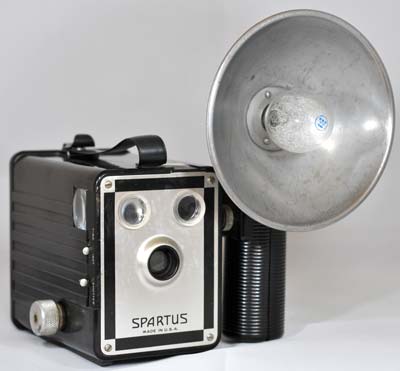Spartus Box 120
Specification

| Manufacturer | : | Spartus |
|---|---|---|
| Produced | : | 1942 |
| Classification | : | Medium Format |
| Body Type | : | Box |
| Construction | : | Bakelite |
| Film Type | : | 120 |
| Film Width | : | 62mm |
| ImageSize | : | 2¼ x 3¼ in |
| No. of Images | : | 8 |
| Lens Type | : | Meniscus |
| Focus Type | : | Fixed |
| Focal Length | : | 105mm |
| Focal Range | : | 8ft - inf. |
| Aperture Type | : | fixed |
| Aperture | : | f/18 |
| Shutter Type | : | Rotary |
| Shutter Speeds | : | T, I*(1/30s) |
| Size Open(w x h x d) | : | 92 x 173 x 112 mm |
| Size Closed(w x h x d) | : | 92 x 124 x 112 mm |
| Weight | : | 449g |
| * Measured on this camera | ||
Art Deco Credentials
![]()
![]()
Acceptable: Modest and restricted
- Produced after the main Art Deco period.
- Moulded Bakelite body.
- Ribbed on each side of body.
- Leather pattern on rear door.
- Geometric pattern in aluminium and black on face plate.
- Art Deco font on front panel.

Description

Spartus Camera Corp. of Chicago, USA, offered a series of simple box cameras having different attractively-finished face plates. They had a ribbed bakelite body with a removable back plate. The camera was capable of capturing eight full size 2¼ x 3¼ inch pictures on 120 film. A variety of designs were produced, some with flash connectors and others without.
The main lens is fixed focus with an aperture of f/18. It has a Time-Instant shutter the function of which is controlled by a lever. The objective lenses of the dual right-angle waist level brilliant finders appear to be made from perspex or similar transparent plastic. The bezels of the viewfinders and lenses are all one piece of clear plastic. Film advance is controlled by a red window which does not have a built-in cover.
The camera shown above has connections for flash on the left hand side which is connected via a pin and knurled nut.
No tripod mounts are available.
How to Use
This camera takes 120 film which is easily available from photographic outlets.
As the shutter speed is only 1/30s, it is advisable to hold it against a wall or other solid object. For quick snapshots, hold it firmly against your body.
If you don't want to bother with an exposure meter, follow the guide shown. It is based on the 'Sunny 16' rule. Film is so forgiving and will produce acceptable results even when overexposed by 2 or 3 stops or underexposed by 1 stop.
The tables assume that the sun is at least 30 degrees above the horizon - that's 10am - 5pm on a summers day (May - August) in the UK.
Remember that the exposure guide in the manual may not be helpful as it is based on the use of old film with a low ISO value.
Using ISO 100/125 film - shutter speed 1/30s
| Weather Conditions | Shadow Detail | Aperture | Exposure |
|---|---|---|---|
 Sunny SunnySnow/Sand | Dark with sharp edges | f/18 | +3 Stops Overexposed Acceptable |
 Sunny Sunny | Distinct | f/18 | +2 Stops Overexposed Acceptable |
 Slight Overcast Slight Overcast | Soft around edges | f/18 | +1 Stop Overexposed Acceptable |
 Overcast Overcast | Barely visible | f/18 | Good |
 Heavy Overcast Heavy Overcast | None | f/18 | -1 Stop Underexposed Acceptable |
 Open Shade Open Shade/Sunset | None | f/18 | -2 Stops Underexposed Not Acceptable |